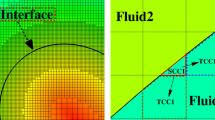Abstract
A sharp interface method has been developed for treating interfacial discontinuities in compressible multi-phase fluids on three-dimensional Cartesian cut-cell grids. The evolution of the interfacial discontinuities in the Cartesian grid is captured by the level-set method. The intersections between interfacial fronts and Cartesian grids are interpolated using level-set function values at the vertices of Cartesian grids. Triangular surfaces are then constructed on the interfacial fronts. A novel cell merge method is used for complex topological changes. Jump conditions across discontinuous interfaces are enforced by reconstruction of interfacial flow variables using a constrained least-squares method. The inviscid flux across internal faces of the same fluid is calculated by the local Lax–Friedrichs flux. Manufactured solutions for interfaces are suggested for validation of the reconstruction method. Laplace’s law test results show that the present method drastically reduces the parasite currents compared to conventional interface treatment methods. Bubble rise problems also show the validity and accuracy of the proposed sharp interface method for immiscible two-phase fluids.




















Similar content being viewed by others
References
Yih, C.-S.: Instability due to viscous stratification. J. Fluid Mech. 27, 337–352 (1967). https://doi.org/10.1017/S0022112067000357
Nourgaliev, R.R., Liou, M.-S., Theofanous, T.G.: Numerical prediction of interfacial instabilities: Sharp interface method (SIM). J. Comput. Phys. 227, 3940–3970 (2008). https://doi.org/10.1016/j.jcp.2007.12.008
Peskin, C.S.: Numerical analysis of blood flow in the heart. J. Comput. Phys. 25(3), 220–252 (1977). https://doi.org/10.1016/0021-9991(77)90100-0
Kim, J., Kim, D., Choi, H.: An immersed-boundary finite volume method for simulations of flow in complex geometries. J. Comput. Phys. 171(1), 132–150 (2001). https://doi.org/10.1006/jcph.2001.6778
Glimm, J.: Tracking of interface for fluid flow: Accurate method for piecewise smooth problems. In: Meyer, R.E. (ed.) Transonic, Shock, and Multidimensional Flows: Advances in Scientific Computing, vol. 1, pp. 259–287. Academic Press Inc. (1982). https://doi.org/10.1016/B978-0-12-493280-7.50016-4
Glimm, J., Grove, J.W., Li, X.L., Shyue, K.-M., Zeng, Y., Zhang, Q.: Three dimensional front tracking. SIAM J. Sci. Comput. 19(3), 703–727 (1998). https://doi.org/10.1137/S1064827595293600
Glimm, J., Li, X., Liu, Y., Xu, Z., Zhao, N.: Conservative front tracking with improved accuracy. SIAM J. Numer. Anal. 41(5), 1926–1947 (2003). https://doi.org/10.1137/S0036142901388627
Fedkiw, R.P., Aslam, T., Merriman, B., Osher, S.: A non-oscillatory Eulerian approach to interfaces in multimaterial flows (the ghost fluid method). J. Comput. Phys. 152(2), 457–492 (1999). https://doi.org/10.1006/jcph.1999.6236
Liu, T.G., Khoo, B.C., Yeo, K.S.: Ghost fluid method for strong shock impacting on material interface. J. Comput. Phys. 190(2), 651–681 (2003). https://doi.org/10.1016/S0021-9991(03)00301-2
Sambasivan, S.K., Udaykumar, H.S.: Ghost fluid method for strong shock interactions Part 1: Fluid–fluid interfaces. AIAA J. 47(12), 2907–2922 (2009). https://doi.org/10.2514/1.43148
Terashima, H., Tryggvason, G.: A front-tracking/ghost-fluid method for fluid interfaces in compressible flows. J. Comput. Phys. 228(11), 4012–4037 (2009). https://doi.org/10.1016/j.jcp.2009.02.023
Bo, W., Grove, J.W.: A volume of fluid method based ghost fluid method for compressible multi-fluid flows. Comput. Fluids 90, 113–122 (2014). https://doi.org/10.1016/j.compfluid.2013.11.013
Hu, X.Y., Khoo, B.C., Adams, N.A., Huang, F.L.: A conservative interface method for compressible flows. J. Comput. Phys. 219(2), 553–578 (2006). https://doi.org/10.1016/j.jcp.2006.04.001
Chang, C.-H., Deng, X.-L., Theofanous, T.G.: Direct numerical simulation of interfacial instabilities: A consistent, conservative, all-speed, sharp-interface method. J. Comput. Phys. 242, 946–990 (2013). https://doi.org/10.1016/j.jcp.2013.01.014
Lin, J.-Y., Shen, Y., Ding, H., Liu, N.-S., Lu, X.-Y.: Simulation of compressible two-phase flows with topology change of fluid–fluid interface by a robust cut-cell method. J. Comput. Phys. 328, 140–159 (2017). https://doi.org/10.1016/j.jcp.2016.10.023
Bai, X., Deng, X.-L.: A sharp interface method for compressible multi-phase flows based on the cut cell and ghost fluid methods. Adv. Appl. Math. Mech. 9(5), 1052–1075 (2017). https://doi.org/10.4208/aamm.2015.m1283
Deng, X.-L., Li, M.: Simulating compressible two-medium flows with sharp-interface adaptive Runge–Kutta discontinuous Galerkin methods. J. Sci. Comput. 74(3), 1347–1368 (2018). https://doi.org/10.1007/s10915-017-0511-y
Quirk, J.J.: An alternative to unstructured grids for computing gas dynamic flows around arbitrarily complex two-dimensional bodies. Comput. Fluids 23, 125–142 (1994). https://doi.org/10.1016/0045-7930(94)90031-0
Lahur, P.R., Nakamura, Y.: Flow calculation of moving body on cartesian grid by using new cell merge method. Trans. Jpn. Soc. Aeronaut. Sp. Sc. 44(145), 171–178 (2001). https://doi.org/10.2322/tjsass.44.171
Osher, S., Sethian, J.: Fronts propagating with curvature-dependent speed: Algorithms based on Hamilton–Jacobi formulations. J. Comput. Phys. 79, 12–49 (1988). https://doi.org/10.1016/0021-9991(88)90002-2
Moës, N., Dolbow, J., Belytschko, T.: A finite element method for crack growth without remeshing. Int. J. Numer. Methods Eng. 46(1), 131–150 (1999). https://doi.org/10.1002/(SICI)1097-0207(19990910)46:1%3C131::AID-NME726%3E3.0.CO;2-J
Enright, D., Fedkiw, R., Ferziger, J.H., Mitchell, I.: A hybrid particle level set method for improving interface capturing. J. Comput. Phys. 183, 83–116 (2002). https://doi.org/10.1006/jcph.2002.7166
Kim, H., Liou, M.-S.: Accurate adaptive level set method and sharpening technique for three-dimensional deforming interfaces. Comput. Fluids 44(1), 111–129 (2011). https://doi.org/10.1016/j.compfluid.2010.12.020
Blazek, J.: Computational Fluid Dynamics: Principles and Applications, pp. 8–19. Elsevier, Amsterdam (2001). https://doi.org/10.1016/B978-0-08-044506-9.X5000-0
Peng, D.P., Merriman, B., Osher, S., Zhao, H., Kang, M.: A PDE-based fast local level set method. J. Comput. Phys. 155, 410–438 (1999). https://doi.org/10.1006/jcph.1999.6345
Jiang, J.S., Peng, D.P.: Weighted ENO schemes for Hamilton–Jacobi equations. SIAM J. Sci. Comput. 21, 2126–2143 (2000). https://doi.org/10.1137/S106482759732455X
Wang, Z.J.: Improved formulation for geometric properties of arbitrary polyhedra. AIAA J. 37, 255 (1999). https://doi.org/10.2514/2.604
Renardy, Y., Renardy, R.: PROST: A parabolic reconstruction of surface tension for the volume-of-fluid method. J. Comput. Phys. 183, 400–421 (2002). https://doi.org/10.1006/jcph.2002.7190
Grace, J.R.: Shapes and velocities of bubbles rising in infinite liquids. Trans. Inst. Chem. Eng. 51, 116–120 (1973)
Annaland, M.V.S., Deen, N.G., Kuipers, J.A.M.: Numerical simulation of gas bubbles behavior using a three-dimensional volume of fluid method. Chem. Eng. Sci. 60, 2999–3011 (2005). https://doi.org/10.1016/j.ces.2005.01.031
Singh, R., Shyy, W.: Three-dimensional adaptive Cartesian grid method with conservative interface reconstructuring and reconstruction. J. Comput. Phys. 224, 150–167 (2007). https://doi.org/10.1016/j.jcp.2006.12.026
Acknowledgements
The first author, Hyoungjin Kim, would like to acknowledge his co-author, Meng-Sing Liou, who was a great mentor, colleague, and friend.
Author information
Authors and Affiliations
Corresponding author
Additional information
Communicated by C.-H. Chang.
Publisher’s Note
Springer Nature remains neutral with regard to jurisdictional claims in published maps and institutional affiliations
Rights and permissions
About this article
Cite this article
Kim, H., Liou, MS. Adaptive Cartesian cut-cell sharp interface method (aC3SIM) for three-dimensional multi-phase flows. Shock Waves 29, 1023–1041 (2019). https://doi.org/10.1007/s00193-019-00902-6
Received:
Revised:
Accepted:
Published:
Issue Date:
DOI: https://doi.org/10.1007/s00193-019-00902-6




